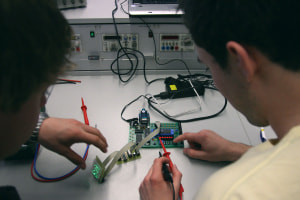When you look at mechatronic systems such as robotic vacuum cleaners, you see they don't need any human control to do their cleaning. They have proximity and other sensors that help automate cleaning and prevent them from hitting obstacles. Do you think the vacuum cleaner would control itself and perform the vacuuming efficiently without sensors? Mechatronic systems require sensors to measure and monitor various parameters to perform their function efficiently. It is essential that anyone who wants to be skilled in mechatronic systems gains knowledge of the working principles of these sensors. This course enlightens you on the working principles and application of the main sensors used in mechatronics. Before getting into the various sensors, you will learn about the different terminologies used in defining their performance. In addition, you will study the differences between sensors and transducers.
An engineer must consider certain factors to select suitable sensors for a project. This course explains the factors to assess when choosing sensors. It introduces you to the various sensors for measuring displacement, position, and proximity. First, you will be shown the working principles of potentiometers and strain gauges and their applications in mechatronic systems. Study how capacitive elements and linear variable differential transformers measure displacements. In addition, learn how encoders measure both linear and angular displacements. The course also explains how capacitive proximity and pneumatic sensors operate and how varieties of switches can act as sensors. Study the working principles of Hall effect sensors and tachogenerators and their importance in mechatronic systems. Next, see how piezoelectric sensors and tactile sensors are used to measure pressure. You will also examine sensors used in measuring fluid flow. The material discusses acceleration and vibration measurement. You will discover how to analyse the frequency response of an accelerometer, including the differences between accelerometers and vibrometers. The course concludes by explaining how microelectromechanical devices work.
To be a sought-after mechatronics engineer, you must understand how various sensors work. Without sensors, mechatronic systems wouldn't be as autonomous as they are today. When you recognise how sensors work, you will implement them properly in your project. Sensors can replace human controls and allow mechatronic systems to perform their functions independently. For example, with autonomous washers, you wouldn't need to keep checking the washing machine to see whether the clothes are clean. With autonomous vehicles, you wouldn't need to drive cars yourself. Sensors that have been properly put in place help do the job for you. This course is designed to show you how various sensors can make your designs efficient and autonomous. Begin this course today and gain the knowledge needed to develop systems that control themselves.
What You Will Learn In This Free Course
View All Learning Outcomes View Less All Alison courses are free to enrol, study, and complete. To successfully complete this Certificate course and become an Alison Graduate, you need to achieve 80% or higher in each course assessment.
Once you have completed this Certificate course, you have the option to acquire an official Certificate, which is a great way to share your achievement with the world.
Your Alison certificate is:
- Ideal for sharing with potential employers.
- Great for your CV, professional social media profiles, and job applications.
- An indication of your commitment to continuously learn, upskill, and achieve high results.
- An incentive for you to continue empowering yourself through lifelong learning.
Alison offers 2 types of Certificate for completed Certificate courses:
Digital Certificate: a downloadable Certificate in PDF format immediately available to you when you complete your purchase. Physical Certificate: a physical version of your officially branded and security-marked Certificate All Certificate are available to purchase through the Alison Shop. For more information on purchasing Alison Certificate, please visit our FAQs. If you decide not to purchase your Alison Certificate, you can still demonstrate your achievement by sharing your Learner Record or Learner Achievement Verification, both of which are accessible from your Account Settings.


















 Avg. Hours
Avg. Hours  CPD Accredited
CPD Accredited 
 Total XP:
Total XP: 
 Knowledge & Skills You Will Learn
Knowledge & Skills You Will Learn 


